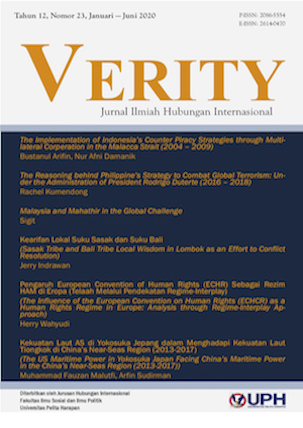MALAYSIA AND MAHATHIR IN THE GLOBAL CHALLENGE
DOI:
https://doi.org/10.19166/verity.v12i23.2484Keywords:
Mahathir, Asian Values, Look East Policy, MalaysiaAbstract
The aim of this study is to analyze Mahathir’s policy through a historical approach to the political developments and challenges in Malaysia. In addition, the author uses secondary data in order to collect several resources related to the topic. The comeback of Mahathir Mohammad, the Father of Malaysian modernization, in the Malaysian 14th general election after leaving the political stage for more than a decade draws many global eyes. As the great critics of the corruption and downturn of Malaysian economic conditions, he decided to run in Malaysia once again. During his previous administration, his mega-project named Pembangunan Putra Jaya and his famous foreign policy “Look East Policy” became a part of his identity. The “Look East Policy” was developed in order to increase domestic economic growth and because Malaysia needed to learn and adopt cultural features from Japan and Korea, such as discipline and hard work. Through this policy, Malaysia began cooperating with East countries (Japan and Korea). In addition, Mahathir had been opposing Western values and deemed them incompatible with Asia. The West considers Mahathir to be an obstacle in uniting Western and Asian countries following the emergence of Asian values since the 1990s. Overall, this study suggests that Mahathir is only focused on his country’s national interest and sovereignty and maintaining Malaysia’s international standing.
Bahasa Indonesia Abstract: Tujuan paper ini adalah untuk menganalisis kebijakan Mahathir melalui perspektif sejarah terhadap perkembangan politik dan tantangan di Malaysia. Selain itu, Penulis menggunakan data sekunder untuk mengumpulkan berbagai literatur terkait dengan topik tersebut. Kembalinya Mahathir Muhammad, Bapak Modernisasi Malaysia, dalam Pemilihan Umum ke-14 setelah meninggalkan panggung politik lebih dari satu dekade telah menarik perhatian masyarakat global. Sebagai kritikus pada korupsi dan kemunduran ekonomi Malaysia, dia memutuskan untuk maju dalam pemilihan umum sekali lagi. Selama pemerintahan sebelumnya, Mahathir dengan proyek megah yaitu Pembangunan Putra Jaya dan kebijakan luar negerinya, terkenal dengan “Look East Policy” menjadi bagian dari identitasnya. Kebijakan “Look East Policy” dikembangkan untuk meningkatkan pertumbuhan ekonomi domestik dan karena Malaysia perlu belajar dan mengadopsi budaya dari Jepang dan Korea, seperti kedisiplinan dan kerja keras. Melalui Kebijakan tersebut, Malaysia telah melakukan kerjasama dengan negara Timur (Jepang dan Korea). Selain itu, Mahathir menolak penerapan nilai-nilai Barat dan menganggap bahwa nilai Barat tidak sesuai dengan Asia. Negara-negara Barat menganggap Mahathir sebagai penghalang persatuan negara Barat dengan negara Asia sejak berkembangnya paham “Asian Values” pada tahun 1990an. Secara Keseluruhan, paper ini berpendapat bahwa Mahathir hanya fokus kepada kepentingan dan kedaulatan negaranya dan menjaga eksistensi Malaysia di dunia internasional.
References
Bernama. (2019, May 12). World recognises Dr. Mahathir's influence, leadership quality. New Straits Times. Retrieved from https://www.nst.com.my/news/politics/2019/05/487768/world-recognises-dr-mahathirs-influence-leadership-quality
Ciorciari, J. (2012). Institutionalizing human rights in Southeast Asia. Human Rights Quaterly, 34(3), 695-725. https://doi.org/10.1353/hrq.2012.0055
Dosch, J. (2014). Mahathirism and its Legacy in Malaysia's foreign policy. European Journal of East Asian Studies, 13(1), 5-32. https://doi.org/10.1163/15700615-01301003
Erickson, A. (2018, August 22). Malaysia cancels two big Chinese projects, fearing they will bankrupt the country. The Washington Post. Retrieved from https://www.washingtonpost.com/world/asia_pacific/malaysia-cancels-two-massive-chinese-projects-fearing-they-will-bankrupt-the-country/2018/08/21/2bd150e0-a515-11e8-b76b-d513a40042f6_story.html
Furuoka, F. (2007). Malaysia-Japan relation under the Mahathir Administration: Case studies of the “Look East” Policy and Japanese investment in Malaysia. Asian Survey, 47(3), 505-519. https://doi.org/10.1525/as.2007.47.3.505
Japan and Malaysia eye close ties based on Mahathir’s ”˜Look East” policy. (2019, May 31). Japan Times. Retrieved from https://www.japantimes.co.jp/news/2019/05/31/national/politics-diplomacy/japan-malaysia-eye-close-ties-based-look-east-policy/#.Xt9B30UzbIV
Mahathir Mohamad sworn in as new leader of Malaysia. (2018, May 11). Al Jazeera. Retrieved from https://www.aljazeera.com/news/2018/05/mahathir-invited-form-government-malaysia-180510083436401.html?xif=
Muda, M. B. (2008). Malaysia at 50: Malaysia’s foreign policy and the Commonwealth revisited. The Round Table: The Commonwealth Journal of International Affairs, 97(394), 121-135. https://doi.org/10.1080/00358530701844726
Sidhu, J. S. (2006). Malaysia-Singapore relations since 1998: A trouble past-wither a brighter future? In R. Harun (Ed.), Malaysia’s foreign relations: Issues and challenges (pp. 75-92). Kuala Lumpur, Malaysia: University Malaya Press.
Thompson, M. R. (2004). Pacific Asia after 'Asian values': Authoritarianism, democracy, and 'good governance'. Third World Quarterly, 25(6), 1079-1095. https://doi.org/10.1080/0143659042000256904
Downloads
Published
Issue
Section
License
Authors who publish with this journal agree to the following terms:
1) Authors retain copyright and grant the journal right of first publication with the work simultaneously licensed under a Creative Commons Attribution License (CC-BY-SA 4.0) that allows others to share the work with an acknowledgement of the work's authorship and initial publication in this journal.
2) Authors are able to enter into separate, additional contractual arrangements for the non-exclusive distribution of the journal's published version of the work (e.g., post it to an institutional repository or publish it in a book), with an acknowledgement of its initial publication in this journal.
3) Authors are permitted and encouraged to post their work online (e.g., in institutional repositories or on their website). The final published PDF should be used and bibliographic details that credit the publication in this journal should be included.


